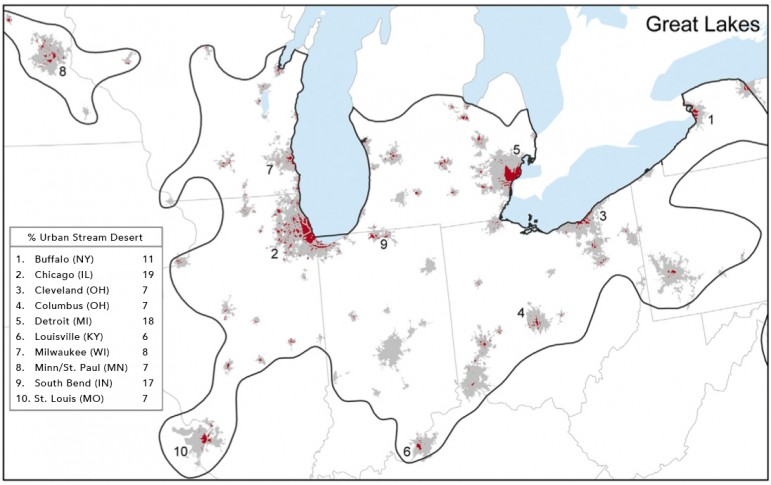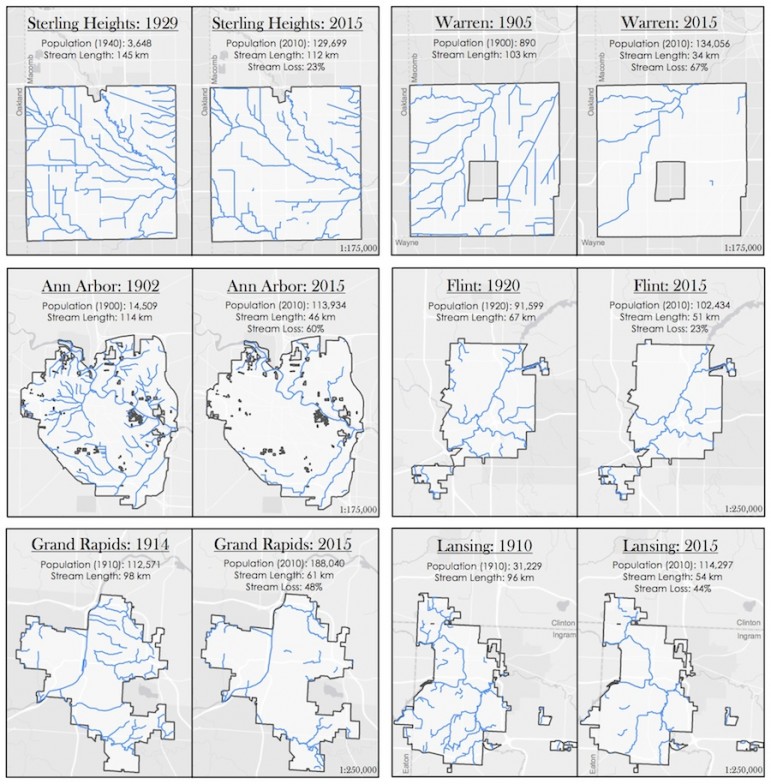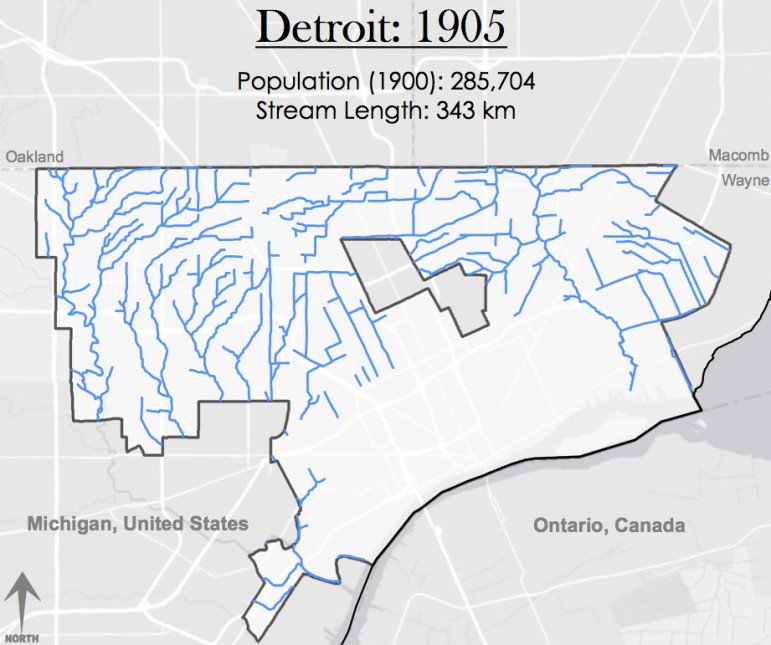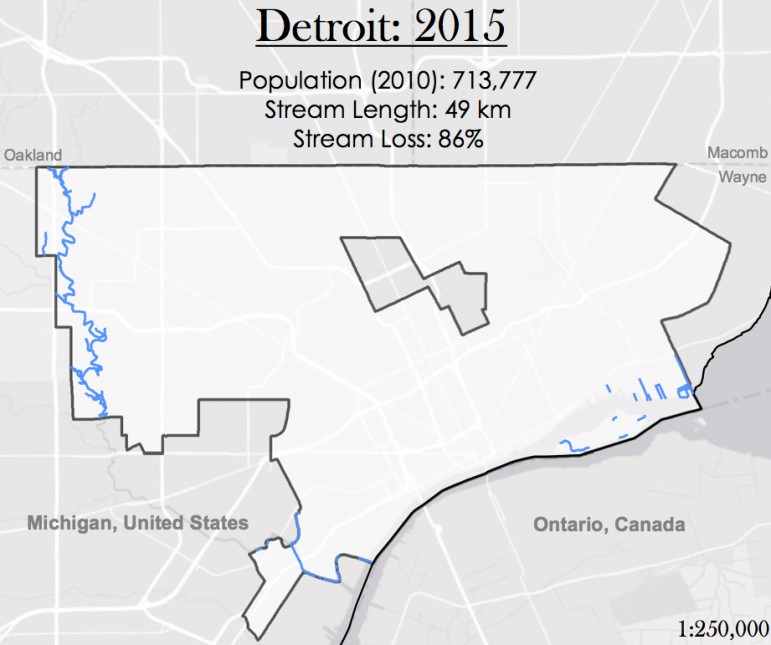By Kevin Duffy
The Great Lakes may boast a fifth of the world’s fresh surface water, but the region is also home to the largest collection of urban stream deserts.

Map and summary table show the relative percent of urban stream deserts (red) within major Great Lakes urban areas (grey). Image: Jacob Napieralski
These riverless areas favor concrete connections over urban parkways. They submerge surface streams, sometimes swallowing entire river systems.
“Urban rivers have value, and when cities start to systematically remove them, they remove viable ecosystem services, like flood control,” said Jacob Napieralski, an associate professor of geology at the University of Michigan-Dearborn.
Detroit alone has lost 86 percent of its surface streams since 1905, according to a study Napieralski recently submitted to the Journal of Maps. That’s roughly 180 miles of stream. Other Michigan cities, including Ann Arbor and Grand Rapids, have seen similar declines, with up to 60 percent stream loss.
Napieralski compared topographic maps from the early 1900s with a recent national surface water dataset.
“There was this desire to link urbanization and population growth with separated stream networks,” he said. “We wanted to map them, to understand where these channels used to be.”
Water within city limits often is polluted by wastewater and stormwater runoff, or it’s buried.
To make way for more people, cities often sink their surface waters.
“It becomes a very dysfunctional part of the stream network,” Napieralski said.
Developers direct the water underground into ditches or artificial pipes, forcing it to flow faster until reconnecting with the main water channels aboveground.
“The water flows out like a firehose,” said Cheryl Nenn, a Milwaukee Riverkeeper who patrols Milwaukee area waterways to expose social and environmental problems.
“This region is dealing with a legacy of development, and it’s finally coming to terms with the problems of stream burial, which can affect human safety.” she said.
Great Lakes urban areas contain nearly 3,200 square miles of these urban stream deserts, according to another Napieralski study. Chicago and Detroit buried the most streams — a fifth of the region’s total.
Detroit and other cities have exhumed some of their lost rivers to increase green space, a process called “daylighting.” But critics argue the water is best left alone.
“If you daylight, you still have to maintain the waterway,” Napieralski said. “In a city like Detroit a daylit stream could collect runoff and contaminants from neighboring areas.”
But advocates of uncovering streams say that those that are daylit require the same management as natural or unburied ones.
It’s really an issue of water quantity versus quality in highly urbanized areas, Napieralski said.
Natural streams regulate water flow. They cycle nutrients and support wildlife. But these vital ecosystem services are lost when a stream is buried, urbanized or both.
“Each ecosystem service has a monetary value, and if they’re removed, then there’s a need to invest elsewhere to fix new problems,” Napieralski said.
Click-and-drag image arrows to reveal stream burial. Images: Jacob Napieralski
Runoff in cities no longer follows the paths of rivers and streams. It overwhelms one or two channels, including the underground passages, pipes and retention basins that house buried streams.
“Billions of dollars have been spent to slow this impact of flooding using retention basins, Napieralski said. “It’s a cost to taxpayers and to the environment.”
Daylighting is expensive, too.
It may come with a high price tag, but “daylighting is becoming an option, especially in this region, where people are highly educated about floods,” Nenn said.
“We look to green infrastructure to protect and improve the area adjacent to streams.”
Despite an uptick in this green infrastructure — working with streams rather than eliminating them — protecting waterways from burial isn’t easy.
“It’s mainly an issue of protecting smaller tributaries not defined as navigable by the Clean Water Act,” Napieralski said. “They still play a critical role, but they’re not protected.”
By removing streams, developers make room for more people, but also lose some of the value they anticipated for that development.
“People are drawn to water and the parks around them,” Napieralski said. “When you remove a river you not only remove its environmental value, you start to see people moving away, seeing vacancy above buried streams.”
Napieralski hopes his maps act as a warning — a lesson learned for developers who threaten a self-regulating system for handling water that benefits the environment and the people who live there.
“This is a precautionary tale about the impacts of rapid urbanization and the decisions we make to ignore long-term sustainability,” he said.

Michigan stream loss makes way for population growth. Image: Jacob Napieralski


True enough, but agriculture is swallowing streams also. If you compared the area of catchment of the city of Grand Rapids with Clinton Co. where nearly all of the tributaries have been dredged and straightened, I think you would be surprised by how damaging the agricultural landscape is. All those dredged streams are adding huge amounts of sand, silt and clay on levels the city is not. It also adds lots of nutrients and pesticides. The fact of the matter is, we are doing terrible things to our streams and we are doing them in widespread areas, not just cities.
If your only criteria is stormwater management then there will be many unforeseen and usually counter-productive results. The same goes if the only criteria is automobile throughput, or dark skies, or bird migration, or ease of garbage collection, or fire department response time, etc.
If streams are considered sacrosanct then you can’t build a city. There’s too many of them to build a comprehensive grid of connected streets to allow for urban density, walkability, and transit use. Instead you end up with disconnected suburban style streets and low density where everyone drives because nothing is close enough to walk to. That defeats the purpose of protecting streams because now you’ve spread the population out over a much larger area impacting significantly more waterways that, even if exposed or left in a natural state, are polluted from parking lot and arterial highway runoff.
The problem isn’t that Chicago or Detroit or whatever central city buried all their creeks. The problem is that they did that AND pro-suburban policies have increased the metro area size while draining people out of those cities, thus negating the urbanist benefits of a small impact footprint and spreading asphalt all over the countryside at the same time.
That row house or apartment dweller in the city may look like a problem with their combined sewer system, old buildings, and lack of permeable surfaces, but their actual per-person footprint on the environment is much lighter than the suburbanite who drives more, uses more energy to heat and cool their larger suburban house surrounded by unnatural turf grasses and pavement, shopping and working in equally inefficient buildings with excessive parking lots that can only be served by trucks rather than trains, all using up more and more land and causing more surface runoff and fouling the waterways at a scale the central city dweller never could.
Very enlightening to know that it is more widespread than I had thought. Toronto has underground streams over which Homes are sinking, sinkholes occurring, we see storm drain covers “launch” like a bullet when there large rains (July 2013). We need to “Daylight” as many of these buried streams as possible, especially for flood control and Wildlife Habitat.